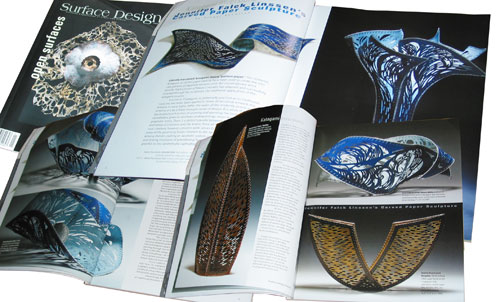
Jennifer Falck Linssen’s work is featured in the Fall 2009 Surface Design Journal in a six-page article, Katagami Inversions: Jennifer Falck Linssen’s Carved Paper Sculptures, by Ginger Knowlton. The article features five dramatic images of hand-carved cotton paper vessels from Linssen’s four-part sculpture series, Wave and Water, Fire and Emotion, Earth, and Wind.
In Knowlton’s view, “[the] process of transference, and of the imagined, is what seems to drive the artist: an exploration between real/physical/tangible and tenuous/ ethereal/potential. On the one level, there is the dynamic between negative and positive space constructed through paper carving, air and light passing through the small pieces of fiber cut away from a larger whole. But there is also the sweep and curve of a vessel filled with…nothing, but in this sense, everything — all of the potential of the absence of the missing elements. This is where Linssen’s sculpture becomes water, or fire, in that essential empty space at once created and surrounded by earth and air elements.“

News Flash: Artists Get Good Press
Lawrence LaBianca in the Aspen Sojourner
Then, in its Holiday issue, Aspen Sojourner printed a lengthy piece about LaBianca’s artist-in-residency at Anderson Ranch, “Ranch Hands: A day in the life of an Anderson Ranch artist-in-resident,” by Hilary Stunda http://softarchive.net/blogs/d3pz4i/aspen_sojourner_usa_holiday.882867.html.
Surface Design Winter 2012
The Winter 2012 of Surface Design,devoted four pages to Kyomi Iwata’s new work in kibisio, a by-product of silk spinning production in Japan, previously considered a waste material http://www.surfacedesign.org/publications/sda-journal. The same issue reviewed New York Fiber in the 21st Century at Lehman College Gallery and featured Tom’s photo of Norma Minkowitz’s King of the Hill and referenced Nancy Koenigsberg’s Light and Tempest, as “challeng[ing] the idea of flatness vs. sculptural, a middle ground that fiber works can uniquely occupy.”
Dail Behennah Grid Dish, 40:40 Forty Objects for Forty Years
The UK’s Craft Council included Dail Behennah’s Grid Dish as one of its 40:40/Forty Objects for Forty Years. You can see all 40 objects at: http://onviewonline.craftscouncil.org.uk/4040/.
Korean Foundation Newsletter 12 2011
The December 2011 issue of the Korea Foundation Newsletter featured a profile of Jin-Sook So in conjunction with coverage of the exhibition of Swedish craft art that she curated in Seoul late last year http://newsletter.kf.or.kr/news/news_201112/eng/sub_02.html. In the piece, “Encounter of Swedish Crafts and Korean Sensibilities; Textile Artist Jin-Sook So’s Views of Contemporary” So explains how Sweden and Korea influence her work. “I’ve lived in Sweden for 30 years and have traveled all over the world to create works and hold exhibitions, but my roots remain in Korea. Although I didn’t intend it to be, Korea and Korean sentiments have served as the spirit and inspiration that have motivated me. As time went by, it became even more evident, and I believe they will remain the roots of my work in the future.”
New York Spaces October 2011
So’s work of steel mesh, Untitled, was also included in the “Art Now” column of New York Spaces last October.
Textile Forum December 2011
Photos of work by three artists represented by browngrotta arts were featured in the December 2011 issue if the ETN textileforum. These included shots of Merja Winquist’s, Winter Garden, her large, on-site installation at the Sofia Paper Art Fest in Bulgaria, Anda Klancic’s lighted work, Aura FM, at the 2011 Como Miniartextil exhibition in Italy and Grethe Sorenson preparing for her Traces of Light exhibition at the Round Tower in Copenhagen, Denmark through March 11, 2012.